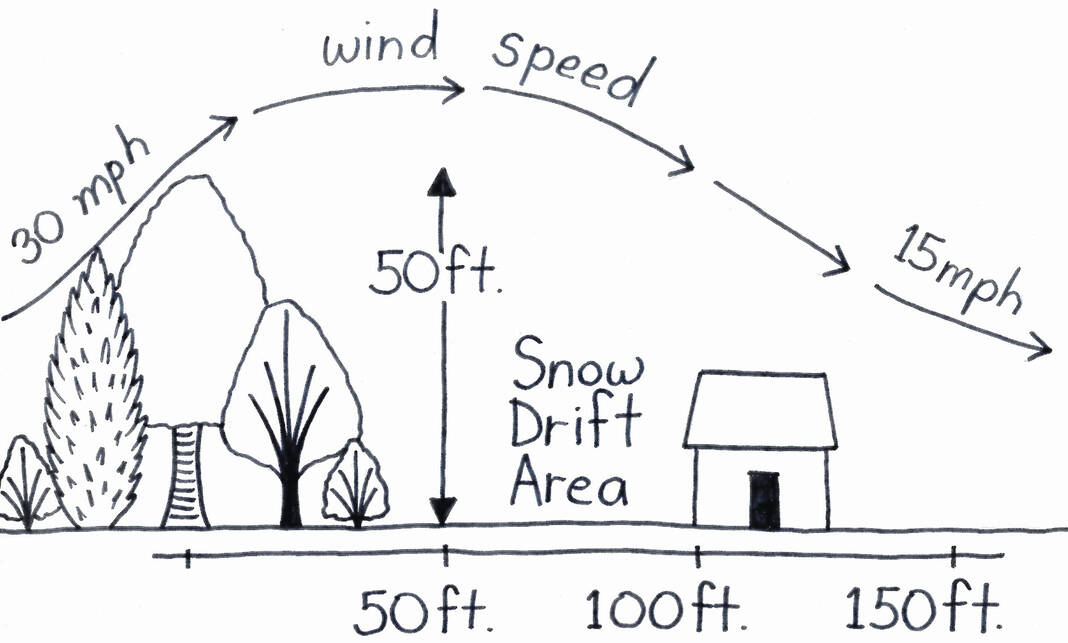
This chart shows the proper placement of windbreak plantings.
Illustration | Marjorie Boehme

Cool, windy days remind us how useful windbreak trees are. Effective windbreak plantings save energy dollars, paying for themselves many times over the years. They also make our lives easier and our homes more comfortable.
Most people think of windbreaks as single rows of trees, closely spaced along property lines, however there are more effective ways to use plants for wind protection. Over the years research has shown that row planting can be ineffective, or even increase wind turbulence in the areas you are attempting to shelter. If you decide to plant a windbreak, take some time to plan it for maximum benefit, and go beyond the traditional, evenly spaced straight row of trees.
An important formula to remember is that the distance between the windbreak and the area getting the most protection should be from two to three times the mature height for the windbreak. For example, Norway Spruce typically grow 50 feet tall, so they should ideally be 100 to 150 feet away from the sheltered area. If they are closer there can be unintended effects such as deep snowdrifts. Greater distances reduce the amount of protection.
An ideal windbreak has several “layers” of protection. Dense evergreens that are winter-hardy make the best perimeter, with a row of sturdy shade trees downwind. The shelter these big plants provide is an ideal place for cold-sensitive fruit trees and flowering shrubs. Trees planted in groups protect each other from buffeting windstorms.
The fastest-growing species are not always the best selections long term. For example, white pines can quickly furnish windbreak and privacy, but they are vulnerable to wind and ice breakage and deer browsing so they may not work out long term. Fast-growing hybrid poplars are often sold as windbreaks, however they are short-lived, messy and have invasive roots.
A better choice for windbreaks is Norway spruce or Colorado blue spruce. These trees make a dense screen planting that gives privacy as well as wind protection. To get a faster result, two rows of trees can be staggered so that the gaps close in quickly, and dense shrubs such as viburnum planted inside the windbreak will offer quick screening. Understory plants located between rows of larger trees provide additional windbreak as well as shelter for wildlife such as birds.
Good windbreak plants are hardy, low-maintenance plants that will survive drought, drying winds and poor soil, since windbreaks are on the perimeter of your property where maintenance is difficult. Often overlooked for windbreak plantings are rugged trees like hawthorn, serviceberry, amur maple and sweet gum. Most viburnum varieties make excellent windbreak and privacy hedges, and some keep their leaves all winter.
Windbreaks also provide shelter and food for wildlife. Most windbreak plants have plentiful seeds and fruit for birds, who nest in their foliage or use it to hide from predators. Planting a windbreak will have more impact on the enjoyment of your yard than many landscape projects costing far more.
Steve Boehme is a landscape designer/installer specializing in landscape “makeovers”. “Let’s Grow” is published weekly; column archives are online at www.goodseedfarm.com. For more information call GoodSeed Farm Landscapes at (937) 587-7021.

